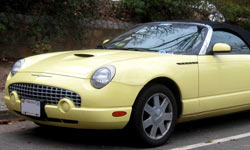Like a Phoenix: A Reborn ’Bird
After 43 model runs and 4.3 million cars, Dearborn’s long-running Thunderbird legacy came to an end on Thursday, September 4, 1997. A red LX coupe, the last of the breed, rolled off Ford’s Lorain assembly line that evening then was donated to the Classic Thunderbird Club International. Sagging sales said enough, and this time there would be no listening to nostalgic pleas to preserve a historic legend like the hue and cry that had saved the Mustang from an unpopular transformation nearly 10 years before.
“Of course we received a ton of calls when we finally made the announcement,” said Ford Division public affairs man Jim Bright. “But once the decision was made, there was no turning back. Ford just let the Thunderbird run its course.” The company also opted not to formally bid bye-bye ‘Birdie. According to one Lorain source, the moment was marked only by “a quiet affair for the plant workers.”
That Dearborn officials seemingly shed nary a tear had nothing to do with heartlessness; they already were looking ahead to a new beginning. ‘Bird watchers were officially informed of a planned reincarnation in May 1998. “A sporty Thunderbird will once again grace America’s roads,” announced Ford Automotive Operations president Jac Nasser. “With the new T-bird, we promise to bring back the magic of owning and driving an American icon.”
Just how important was preserving this particular icon? “The Thunderbird has an emotional hold on the American public that spans decades and generations,” added Nasser in January 1999. “This timeless classic is an important part of Ford Motor Company’s heritage and, indeed, this country’s automotive history.”
A reborn two-seat Thunderbird appeared first in concept car form during the North American International Auto Show in Detroit in January 1999. The work of Ford Design chief J Mays, this concept clearly honored classic roots. “Simple shapes combined with timeless materials and textures convey a relaxed, confident look and a feel that is the true essence of the original Thunderbird,” explained Mays. Something old, something new also was part of Mays’ plan. “It’s not retro,” he said. “While the concept is loaded with heritage cues, it is a decidedly modern machine.”
When it debuted as a 2002 model, Mays’ pride and joy certainly brought back memories. But sales again were limited by its highly personal nature, inspiring Ford to once more bid farewell to the Thunderbird three years later.


